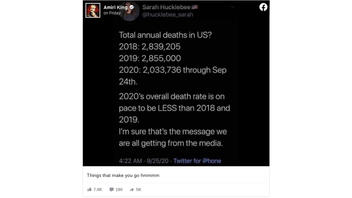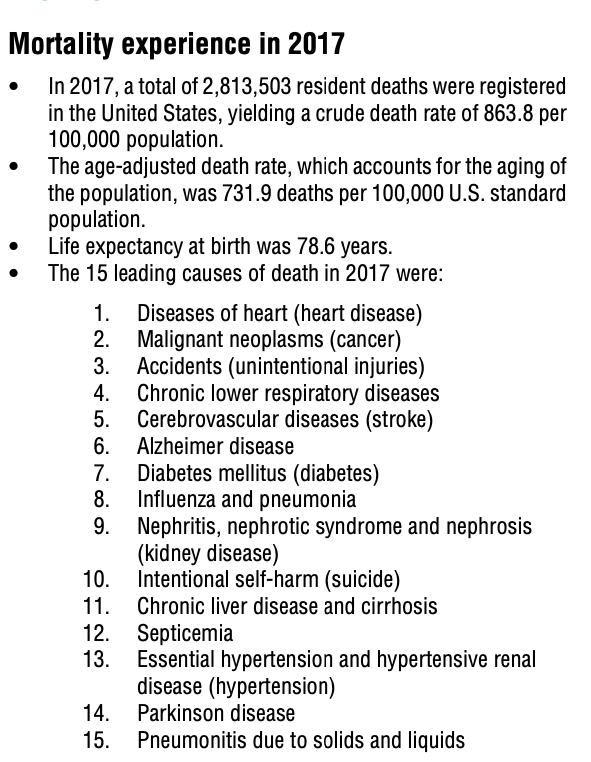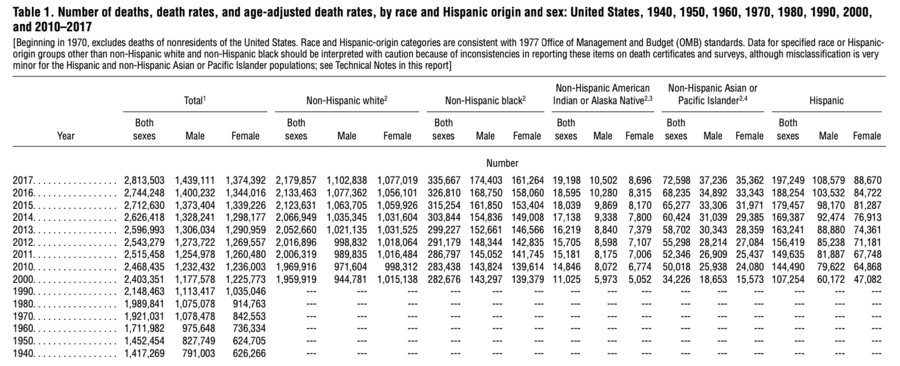
Is it true that, even with the coronavirus pandemic, the United States is on pace to have fewer total deaths this year than in both 2018 and 2019? No, a rough estimate doesn't account for the complexity of seasonal changes in death rates. The year is just over nine months old, and with reports warning of a "twindemic" with the novel coronavirus and the seasonal flu, it is too early to declare 2020 will end with fewer deaths, according to experts, who predict a higher toll due to COVID-19.
The claim appeared in a post (archived here) published to Facebook October 2, 2020. It opened with a short quote stating "Things that make you go hmmmm." The post is mostly a screenshot of a September Tweet, reading:
Total annual deaths in US?
2018: 2,839,205
2019: 2,855,000
2020: 2,033,736 through Sep 24.
2020's overall death rate is on pace to be LESS that 2018 and 2019.
I'm sure that's the message we are all getting from the media.
This is what the post looked like on Facebook at the time of writing:
(Source: Facebook screenshot taken on Tue Oct 6 16:14:14 2020 UTC)
The post uses accurate numbers from the Centers for Disease Control and Prevention. In a year when COVID-19 claimed more than 211,000 lives in the U.S. by early October -- before influenza season had started -- experts said it's too soon to know whether overall deaths be higher or lower by year-end.
Asked by Lead Stories about 2020 death totals, the CDC responded in an email:
The CDC's National Center for Health Statistics (NCHS) won't have 2020 final death data until late in 2021. The data becomes final when 100% of death certificates are certified and submitted by state vital statistics offices to NCHS. The most recent final data we have is for 2018, and that was just released in January of this year."
The claim is based on this back-of-envelope calculation: The 2020 U.S. death count through Sept. 24 cited in the post, if divided by the number of days (267) yields a deaths-per-day average of 7,617. Multiplying that by 366 (it was a leap year), the number of days in a year, yields a deaths estimate that would be lower than the year-end totals for 2018 and 2019.
That, however, "is not the correct way to do this," when it comes to measuring death totals, wrote Dr. Robert Anderson, chief of mortality statistics at the CDC's NCHS, in an email to Lead Stories on October 9, 2020.
Mortality is seasonal, that is, it increases in the winter and decreases in the summer. This "back of the envelope" method ignores the normally expected increase in mortality from Oct-Dec, not to mention the fact that COVID-19 could further push these numbers up. Since February, weekly deaths in 2020 have been higher compared to the same time period in previous years. A more appropriate way to look at this is in terms of excess deaths, i.e., the number of deaths this year compared to what we would expect in a normal year (see https://www.cdc.gov/nchs/nvss/vsrr/covid19/excess_deaths.htm). Even the more conservative estimate indicates that deaths have increased by more than 200,000 above normal."
So the post does not account for the unpredictability of COVID-19, which has shown an uptick in most states in the country recently. As Dr. Richard Jackson, professor emeritus at the Fielding School of Public Health at the University of California, Los Angeles, and a former CDC official, cautioned:
The US has averaged about 30,000 COVID deaths per month since the big jump at the beginning of April. We are now at 211,000 deaths and have 3 months left. We will almost certainly exceed 300,000 by the end of the year. There is no believable prospect for a vaccine in 2020."
So, according to figures from Jackson, who is also a trained epidemiologist, the implication in the Facebook post, which is made repeatedly by commenters on the Twitter page, is that COVID-19 has somehow been overblown or is a hoax is misguided.
Collecting these data from many jurisdictions and systems is difficult and slow. If the 2017 example...were to be replicated with 2.8 million deaths, plus 300k from Covid, almost certainly 3.1 million ... the NCHS (National Center for Health Statistics, part of the CDC) tries to make the numbers very precise, and it takes months to identify all cases across the country and their final causes. Given Covid, I would not be at all surprised if the 2020 breaks 3 million."
Jackson was referring to these 2017 numbers:
What we do know is that 211,132 people in the U.S. have died of COVID-19 as of October 8, 2020, according to the CDC, or 212,840 as reported by Johns Hopkins Coronavirus Resource Center.
We also know that some 62,000 people died during the 2019-2020 flu season, although the CDC cautions it is an estimate since not all influenza deaths are reported. A big unknown for the 2020-2021 season is how it will impact the ongoing coronavirus pandemic. Fearing for the worst -- a "twindemic" -- experts and doctors are urging flu vaccinations.
Because the COVID-19 death tally and seasonal flu tallies have become the focus of political debate and misinformation, public health experts have begun directing people to look at the "excess deaths" chart. That statistic takes the average monthly mortality count for a given country and compares that prior years' number of deaths to the current-year number. That difference, called "excess deaths," shows many more deaths this year than expected, at a time when no new public health menace other than COVID-19 is afoot.
Here is the original tweet forecasting 2020 will have a lower death total in the U.S. from a spoof account "Sarah Hucklebee" -- not Sarah Huckabee Sanders (@SarahHuckabee), who was President Trump's press secretary and adviser from 2017 until 2019.
2018: 2,839,205https://t.co/mFih7MKaZR
-- Sarah Hucklebee🇺🇸 (@hucklebee_sarah) September 25, 2020
2019: 2,855,000https://t.co/CA0DgjZNyP
2020: 2,787,590 annualized
2,041,186 through Sep 25th https://t.co/n1C9XZv6rB
2020 pace is showing the first decline in year-over-year total deaths, since 2009. https://t.co/7DwxbKW2XP
Here is the "Hucklebee" account's description page on Twitter:



















